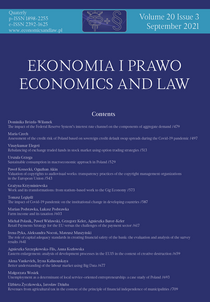Eastern enlargement: analysis of development processes in the EU15 in the context of creative destruction
Eastern enlargement: analysis of development processes in the EU15 in the context of creative destruction
Author(s): Agnieszka Szczepkowska-Flis, Anna KozłowskaSubject(s): Economic policy, Comparative politics, Economic development, EU-Accession / EU-DEvelopment
Published by: Wydawnictwo Naukowe Uniwersytetu Mikołaja Kopernika
Keywords: creative destruction; eastern enlargement; economic development;
Summary/Abstract: Motivation: Studies on the impact of the Eastern enlargement on economies of the EU15 indicate that the new member states could not be a significant engine for development processes. However, this does not exclude that the Eastern enlargement and acceding countries could have a significant impact on the mechanisms of the development of the EU15. If we consider Eastern enlargement as a Schumpeterian innovation, its longterm effects should be evident in the way creative destruction affects economic development. Aim: The aim of the study was to determine the impact of the Eastern enlargement on the economic development of the EU15 in the context of creative destruction. In particular, the aim of the empirical analyzes was to determine whether and to what extent the enlargement of the EU was a factor modifying the impact of creative destruction on the development of “old” members countries, and to identify the role of the new member states in these processes. Results: Econometric analysis confirmed that creative destruction influenced economic development in the EU15, and that Eastern enlargement was a factor modifying the relationship between creation, destruction, and the rate of change of GDP per capita. The Eastern enlargement has mobilized two opposing forces. The “internal” force resulting from market selection in the EU15, which after 2004 became an active component of creative destruction, contributing however to a lower rate of change in GDP per capita. The “external” force, related to the mechanism of transmission of impulses within the grouping: synergy effects from destruction in new member countries were a catalyst for the development processes of the EU15, and synergy effects from creation were inhibitors for these processes. In the context of our research the “development leaders” can be considered the largest beneficiaries of Eastern enlargement in the EU15
Journal: Ekonomia i Prawo. Economics and Law
- Issue Year: 20/2021
- Issue No: 3
- Page Range: 659-675
- Page Count: 18
- Language: English

